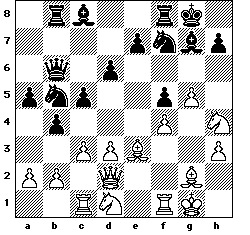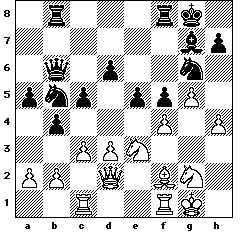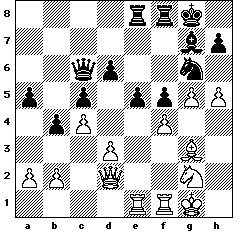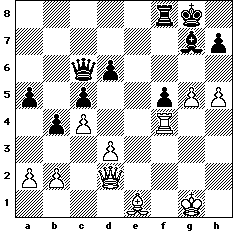
It is fitting, perhaps, that the youngsters are crazed with chess these days. You'll recall that the last time this happened was the early 1970s. Then, it was Bobby Fischer's success that seemed to draw American youth to the game. In a sense, Bobby's back, and apparently again with a comparable impact. It might have been his recent match against Spassky, or the recent movie with his name in the title. Perhaps it was the thrill of having three (four with Bobby!) World Championship matches going on around the same time. Or the presence of so many software programs for chess. The effect is clear enough. You may have seen it your local club too. We're awash in kids!
Every Thursday night, my friend Matt and I are teaching chess to more than 20 of them, including three Russian emigres. This past Wednesday, I gave a simul to more than 30 while Matt took on many more. I added a short lecture: take the center to make your pieces good, rooks on open files, occupy the holes, knights on the rim are dim, develop quickly, move pieces only once in the opening, castle early, sit on your hands, knights before bishops... you all know the routine. There's really only one problem with it... I seem to pay remarkably little attention to these rules myself.
In this game, the queen's bishop stays home far longer than my students would ever permit it to... and I really can't imagine any of them developing their knights via the corner. But surely, the most memorable moment came on Stephan's card in response to my ...Nh8. I can vividly imagine the consternation upon his face when he realized that I had moved a knight to the corner before he could!
1. e4 c5
2. Nc3 Nc6
3. g3 g6
4. Bg2 Bg7
5. d3
Another Closed Sicilian, our fourth or fifth depending upon whether or not you include that silly game at the First Annual Massachusetts Beer Drinkers Open. Stephen insists that he won that game, but I have no memory of the result.
Loyal followers of Stephan's may recall our last encounter, which graced these pages more than a year ago and found its way a bit later into his marvelous new book: Journal of a Chessmaster. That game involved my use of rather strange and almost certainly unsound line; understandably, Stephan hoped to repeat it and now offered what remains for me the most unusual if move I have ever received. He offered to let me repeat the moves all the way to move 10... or not at all! I wasn't sure about the absolute legality of the offer, but I was sure that I wanted nothing to do again with that crazy line!
5. -- d6
6. Be3
Stephan deviates from our past encounters. By developing the bishop early, white aims to save a key tempo over other closed lines by avoiding the future need for Rb1. Instead, white will play Qd2 and, as necessary, Nd1, to hold the b-pawn. To counter this strategy, black needs to develop quickly and actively on the queenside. In this variation, black can also try to take advantage of the fact that the Ng8 has not yet developed. In some lines, black develops the Ng8-f6. More often, black plays e7-e6 and Ng8-e7 where the knight is less liable to attack during white's kingside pawn storm. In this variation, black gains a third option, as you shall soon see...
6. -- Rb8
The usual square for the rook, with the idea of supporting b7-b5 and obviously moving the rook off the dangerous long diagonal.
7. Qd2 b5
8. f4 b4
9. Nd1
"I am in earnest - I will not equivocate - I will not excuse - I will not retreat a single inch; and I will be hard!
-William Lloyd Garrison, The Liberator
The knight is actually very usefully placed here. It holds the b-pawn, supports the later c2-c3, and can enter the game more powerfully by supporting the center (Nd1-e3) or the kingside assault (Nd1-f2-g4).
At this point, I wrote in my notes to the game: "Chess as a game requires tremendous patience, in stark contrast to the mate-in-two puzzles that we see in the local papers. Stephan has always seemed to understand this well. When I play him, I must keep in mind throughout that he is most at home in slow, cautious maneuvering contests, in which the slightest weaknesses become greatly magnified."
9. -- Qb6
In addition to supporting the queenside expansion, the queen can often be redeployed later along the third rank.
10. Nf3 f5
A thematic play in the closed, with the idea of fixing white's f-pawn on a dark square in order to lessen the mobility of the Be3 and Qd2. I usually play the move only after white's g4, just before white's f4-f5 push. In this case, if white wants to develop the Ng8 to h6 (to to f6 behind the f-pawn), the pawn must move now.
11. 0-0 Nh6!? TN
Obviously, my students wouldn't approve of this ugly looking move, but it does have its points. 11...Nf6 works fine after 12.e5 Ng4! but leaves much to be desired after 11...Nf6 12.exf5!
With 11...Nh6, I still respond to 12.e5 with 12...Ng4. Here, however, I gain an adequate response to 12.exf5 Nxf5.
12. h3!
"Keep strong, if possible. In any case, keep cool. Have
unlimited patience. Never corner an opponent, and always assist
him to save his face."
- Basil Henry Liddell Hart
Advice to Statesmen
White's best chance for an edge. As they say, "the threat is stronger than the execution." White steals the g4 square, keeping the black knight on the dim rim, and prepares the e5 push (or so I assumed).
12. -- 0-0
13. Nh4 !?
White often plays this move in the closed in order to open the h1-a8 diagonal and to prepare the idea of g3-g4-g5-g6. As you might expect, black does get good play after 13.exf5 Nxf5 14.Bf2 Ncd4 15.Nxd4 Nxd4 16.c3 bxc3 17.bxc3 Qa5. However, I expected 13.e5 Nf7 14.d4 Ba6 15.Re1 with interesting chances for both sides.
13. -- a5!
Required to maintain the queen on b6 and to prepare the Nc6-d4 advance. Black wants to entice the c2-c3 push, but in so doing, I need to be able to respond to the c3xb4 capture with the a-pawn (note that the c-pawn is well pinned!).
Playing Stephan brings back fond memories of my chess days as a teenager in New England. I remember that, as a young player, I asked one of the stronger players what I needed to do to improve. He suggested that I watch the games of the strongest players and listen as they analyzed their games.
To this day, Jim Rizzitano runs in the other direction when I come near, I think out fear that I'm out to steal some deep secrets. The fact is, I learned a lot from him. One of the most memorable lessons had to do with his treatment of his queen's bishops. He rarely ever moved them! Here too, it's not yet clear where the bishop ought to go. To e6? to b7? For the moment, it's keeping a useful eye on the f5-pawn. In Rizzitano's games, the bishop always seemed to develop late and then with a huge bang to exactly the right square. Here too, perhaps?
It was clear that 13...Be6? permitted 14.g4 (14...fxg4 15.f5+-). I also went through some rather fun if unscientific analysis with 13...Kh8!? 14.Kh2 a5 15.g4 fxg4 16.f5 gxh3 17.Bxh3 Be5 18.Kg2 Ng8 19.Rh1 gxf5 20.Ng6+ hxg6 21.Bxf5 Kg7 22.Bh6+ Kf7 23.Bxg6+ Kxg6 24.Qg5+ Kf7 25.Qh5 Ke6 with a perpetual. I don't doubt that white has better there.
14. g4
White has to play this advance sooner or later in order to carry out the kingside attack. On other moves, black will occupy d4 in the hope of encouraging white to play c3. As in so many of these Closed Sicilian lines, black will be fine here only if the f5 outpost can be maintained.
14. -- Nd4
Taking a share of the center, further protecting the key f5 square, shielding the Qb6, enticing c3, freeing the diagonal for the Bc8-b7, and further limiting the scope of the Be3.
15. exf5
I teach this one to the kids too. When you have such a three on one pawn attack, very often you will capture with one and then push through with the other. The only thing I don't like about the line, however, is that black gains no useful way to mobilize on the dark squares. We had to analyze 15.c3 Nb5 16.exf5 gxf5 17.g5 Nf7 18.g6 Nh6 19.gxh7+ Kxh7 20.Kh2 Bb7 with good play for black. This line shows again the importance of remaining patient with the Bc8. As here, when white chooses to open the h1-a8 diagonal, black stands ready to play Bb7.
15. -- gxf5
16. g5 Nf7
17. c3
White succeeds in driving off the well-placed Nd4, but at the cost of creating an important target on c3. For the tactically minded among you, take a look at 17.g6 Nd8!? 18.gxh7+ Kxh7 19.Nf2 Bb7 20.Bxd4 Bxd4 21.Qe2 Bxg2 22.Qh5+ Kg8 23.Qg6+ Bg7 24.Kg2 d5 with interesting play. Such open lines, however, are not to Stephan's taste and, at least here, seem fine for black.
17. -- Nb5
The knight retreat to b5 applies pressure to c3. 13...a5 should now make sense: 18.cxb4 meets ...axb4!
18. Rc1!?
Not what I expected, but a compelling idea. White wants to free the Nd1-e3-c4 or Nd1-f2-g4; white therefore needs some added protection for c3. My main line was 18.g6 Nh6 19.gxh7+ Kxh7 20.Nf3 Bb7 21.Ng5+ Kh8 22.Kh2 [22.Ne6 Rg8] 22...Rg8 23.Rg1 d5 activating the queen!

18 -- Nh8!
"It is better to dwell in a corner of the housetop, than with a
brawling woman in a wide house."
- Proverbs 21:9
18...Nd8? 19.cxb4 axb4 20.Qxb4! cxb4 21.Bxb6+- because the Nd8 prevents the Rf8 from defending the Bc8. This is the first time that I've ever played a knight to the corner in a correspondence game. It's a nice feeling, especially to do it against the master of such maneuvers! Obviously, the knight won't stay long on h8. On f7, it impeded the communication between the Rf8 and the key f-pawn. With that communication restored, black will be free finally to redeploy the Bc8-b7 in order to exchange off white's powerful Bg2. For its part, the Nh8 will move to g6 where, in addition to exerting pressure upon white's f-pawn, it can support ...e5 with good play down the e- and f-files.
19. Bf2
Stephan's moves are surprisingly hard to predict. In fact, I have found that I can usually understand Stephan's play only after he makes his moves. Here, he aims to clear the e3-square for the Nd1-e3 en route to c4 or d5.
19. -- Bb7
Gee, maybe my students will be able to understand this game after all! Black finally is able to trade his relatively "bad" bishop (the black f-pawn does limit its mobility) for white's "good" bishop.
20. Ne3
There's no good way to avoid the exchange of bishops (20.Nf3 Bc6 with the idea of Qb7), but white sure doesn't have to make matters worse by ceding the diagonal with tempo after 20.Bxb7 Qxb7.
20. -- Bxg2
21. Nhxg2
This is better than 21.Kxg2 Ng6 22.Nexf5 Nxh4+ 23.Nxh4 bxc3 24.bxc3 Nxc3 25.Rxc3 Bxc3 26.Qxc3 Rxf4 with ...Qb2 to follow.
21. -- Ng6
22. h4 e5
"For this thing was not done in a corner."
- Romans 26:26
The idea of h5 forces immediate action. White comes alive after 22...e6? 23.h5 Ne7 24.Nc4 Qc7 25.h6 Bh8 26.Rfe1 e5 27.Bg3.

23. Nd5!?
A surprise. I had assumed that c4 was the better square for the knight. To sustain the knight on d5, white must weaken his pawn structure with c4, essentially creating the d4-hole for black to use. A knight on d5 is also an easier target. By contrast, on c4, the knight attacks two pawn weaknesses (a5 and d6) and places additional pressure upon the e5-square.
23. -- Qb7
Preserving options along the seventh rank and placing the queen upon the key diagonal.
24 c4
This is an important concession. It will be very hard now for white to break free with d4; as a result, the white d-pawn will remain a key target. He may have thought that I wouldn't have time to occupy the d4-square, since the immediate 24...Nd4? meets 25.Bxd4 exd4 26.Rce1 Re8 27.Rxe8 Rxe8 28.Re1 with a big edge.
24. -- Nc7
25. Nxc7
The only try. Retreating the Nd5-e3 would block the e-file and permit black to make full use of both long diagonals. The only alternative is 25.h5!? Nxd5 26.hxg6 (26.cxd5 Nf4 -+) 26...Nxf4 27.Nxf4 exf4 28.gxh7+ Kxh7 29.Qxf4 Be5! 30 Qh4+ Kg8 with the idea of Qg7 and Rbe8.
25. -- Qxc7
26. Bg3
26.fxe5 Nxe5 would give the knight a victory. Black would proceed with the idea of Qc6 and Rbe8, with full command over all of the key squares.
26. -- Rbe8
At the time, this was a tough decision although, looking at it now, it seems quite clearly the only reasonable choice. I struggled with the possibility of playing 26...b3, but white can seal the queenside pawn structure with 27.a3, tying black to the defense of the queenside pawns. As I tell the kids, place your pieces on the most active squares and good things will happen!
27. Rce1 Qc6
28. h5
Undoubtedly seeing the finish, Stephan offered a draw. As my students might say, black has the better bishop, the better knight, the better rooks, and even the better queen! There should be something there!

It is indeed black to move and win. See if you can work it out!
28. -- exf4!
29. Nxf4
Black emerges up a healthy pawn after 29.hxg6 fxg3 30.gxh7+ Kxh7 31.g6+ Kg8 while 29.Rxe8 only further activates the black rooks. For example, 29.Rxe8 Rxe8 30.hxg6 fxg3 31.hxg7+ Kxh7 32.Rxf5 Bd4+ 33.Kf1 (31.Kh1 Kg6 -+) 33...Kg7 -+ since 34.Qf4 Qa4! 35.Rf7+ Kg8.
29. -- Rxe1!
This must be played first! After 29...Bd4+? 30.Kh2! Rxe1, white can play 31.Nxg6! because ...Rxf1 is not check! Black gets nothing after 29...Nxf4? 30.Bxf4 Rxe1 31.Qxe1 Re8 (31...Bxb2 32.Qe6) 32.Qd2=
30. Bxe1
30.Rxe1 Bd4 [now!] 31.Kh2 (31.Bf2 Nh4 -+) 31...Ne5 (with the idea of Nf3+) 32.Qg2 Qxg2 33.Kxg2 Bxb2.
or 30.Qxe1 Bd4+ 31.Kh2 (31.Bf2 Nxf4 Δ Qg2#) 31...Re8 (ΔNe5-f3)
30. -- Nxf4
31. Rxf4
31.Qxf4 Bxb2 32.g6 hxg6 33.Qh6 gxh5! since 34.Qg6+ Bg7 -+

This one stumped the guys in the club: It's black to move and threaten two thing at the same time.
31. -- Qe8!
32. Rh4 Bxb2
33. Bf2 Bc3
34. Qd1 a4
35. d4 cxd4
36. Rxd4?!
"My silks and fine array,
My smiles and languished air,
By love are driv'n away;
And mournful lean despair
Brings me yew to deck my grave:
Such end true lovers have."
- William Blake, My Silks and Fine Array
36. -- Bxd4
37. Qxd4 Qxh5
38. Qd5+ Qf7
0:1